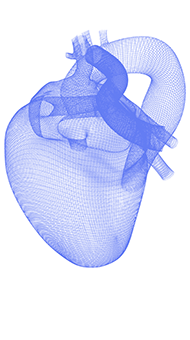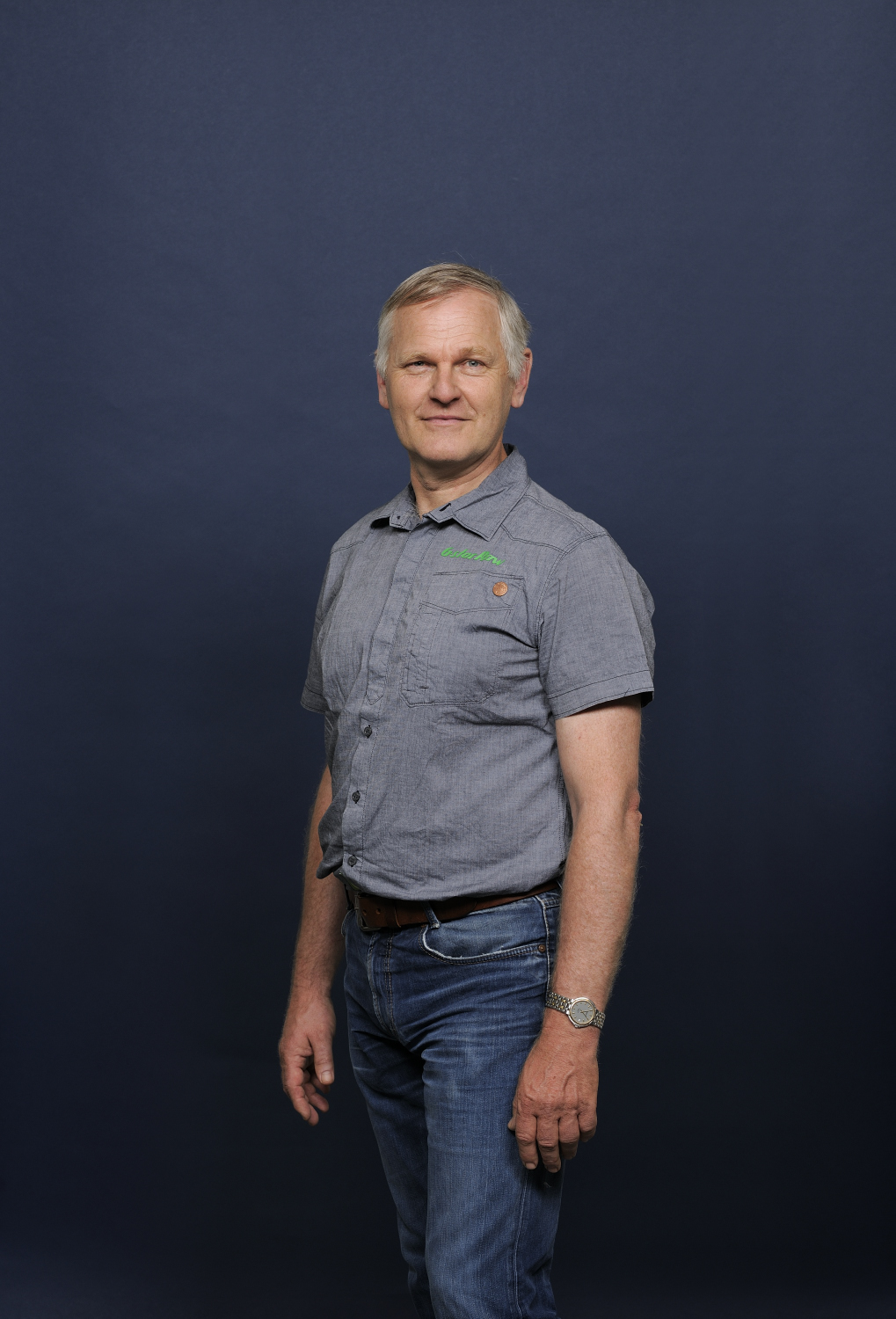Healthy mathematics
Kees Vuik |
Running models to one's heart's content
Medical imaging was the first area in which mathematics offered health care a helping hand. However, building these models was not all plain sailing. Vuik: ‘The images were very blurry, we could hardly make anything out. With today’s advanced numerical models, we can use an MRI scan to see a lot more of what is happening inside a patient’s body.’ All the same, the scanners – which are always improving and supplying more and more data – are nothing without the support of mathematics. ‘Without intelligent algorithms or models, it is not possible to interpret the data. You truly need them in order to make progress.’ On the heels of imaging, other medical applications of mathematical models followed. This process started years ago with manually predicting the rise in temperature of human tissue during treatment of several cancer patients, and now with mathematical modelling of the formation of scar tissue following burns. Vuik believes that a major advantage of his field is the lack of constraint by ethical or practical objections linked to experimentation on animals or patients. ‘You can run a model to your heart’s content. After all, the computer does not feel a thing.’

Mathematisation
However, applied mathematics sometimes must take responsibility. Vuik: ‘Overseas colleagues of mine work together with vascular surgeons. The operation is paused so that mathematicians can run a model to determine which treatment has the greatest chance of success. In this case, a miscalculation can be the difference between life and death.’ This is a concrete example of applied mathematics for which Vuik believes there is great demand in this day and age. And not only in the health care sector. ‘The number of applications is on the rise,’ says Vuik. ‘Algorithms offer you news or music, and even determine which films you will enjoy. Every aspect of our society is becoming mathematicised, and the ever increasing processing power of computers only adds to this.’
Collaboration
Vuik still believes that pure mathematics also has its part to play. ‘The professional world sometimes presents us with questions that we are unable to address with current mathematics, so we will have to develop new forms of mathematics. And the reverse is also true: new methods are developed by pure mathematicians, who would never have thought that we could apply their methods in practice. This is not about one-upmanship - we simply need each other.’ While some exact scientists feel at ease with pure mathematics, Vuik argues the case for broad collaboration, also with other fields. ‘Consider the great mathematicians, they were also often biologists or physicians. Newton needed the differential calculus to progress, and without mathematics, Einstein would never have formulated the theory of relativity. Keep working as an expert in your own field, but also look beyond. That will lead to improvements in both mathematics and its application.’
‘Every aspect of our society is becoming mathematicised’
Predicting and minimising scarring
Supported by the Dutch Burn Centre in Beverwijk, PhD candidate Daniël Koppenol is researching the formation of scar tissue following burns. ‘The two most important processes related to scar tissue formation after burns are excessive tissue formation and skin tension, or contractures,’ explains Daniël’s co-promotor Fred Vermolen, Associate Professor of Numerical Analysis. ‘We can explain both processes based on the presence of specific connective tissue cells, called myofibroblasts, in the burn. These cells produce more scar tissue and pull harder on the surrounding tissue than other cells.’ In his research, Daniël created a mathematical model to predict these two processes, in the knowledge that the myofibroblasts will eventually disappear from the skin. Vermolen: ‘They ultimately commit a sort of mass suicide (apoptosis). If you can use a model to predict when this will happen, you can use this to your advantage.’ For example, by administering a hormone or growth factor causing the myofibroblasts to die earlier, or to mechanically influence the skin. ‘If the cells are exposed to traction, they either die or grow faster. We may be able to influence this process using a splint on the skin.’ Vermolen hopes that a predictive calculation will be developed in the future. Individual predictions, based on the type of burn and skin type, so that patients are able to find out the likelihood of contracture or a large scar developing. ‘And we could then reduce the likelihood using medication or a splint. In light of the quantifiable nature of our field, mathematics could make a significant contribution in this regard.’
‘We could reduce the likelihood of a large scar developing’
Responding to arteriosclerosis
Johan Dubbeldam, Associate Professor of Mathematical Physics at TU Delft, uses mathematics to model the process of arteriosclerosis, or hardening of the arteries. Under the influence of high cholesterol levels, deposits from white blood cells – so-called plaques – will remain present in the blood vessels. These plaques may grow and eventually block a vessel, or break off and cause a myocardial or cerebral infarction. Dubbeldam is attempting to mathematically model what happens when a plaque forms. He hopes to shed light on this process by including the most significant variables, such as LDL cholesterol levels, the growth speed of white blood cells and the influence of exercise. ‘Blood flows faster when you exercise, increasing the shear force in the blood vessel. As a result, the inside of the blood vessel remains nice and smooth. In the case of a plaque, the blood swirls behind it, and the shear force on the wall of the blood vessel is lower than elsewhere. In turn, this means that white blood cells and cholesterol will get trapped behind the plaque, so the plaque grows more rapidly. That is why the influence of exercise is so compelling.’ Dubbeldam ultimately hopes to use his model to predict how fast a plaque will grow: under the influence of which values does it grow the slowest? ‘Things get dangerous when the plaque rips open. I would therefore like to use my model to predict how much force is required to reach this point, if we include the shape and composition of plaques in the calculation. I think it would be great if we could make actual predictions about this in the near future.’
‘I think it would be great if we could make actual predictions in terms of how fast plaques grow’
Minimising radiotherapy treatment times
Marleen Keijzer, Professor of Applied Mathematics at TU Delft, is using mathematical models to optimise how cancer patients receive radiotherapy. ‘You want to irradiate the tumour in the most optimised way, while minimising damage to the surrounding tissue. That is why you irradiate the tumour from multiple sides, and you spread the dose over up to 40 treatments. But how do you weigh up all the variables? What is still good enough, and when does it become dangerous? Radiotherapy is ultimately one huge optimisation issue.’ Until recently, a member of hospital staff would look into this process. Even with the help of computer programmes, it easily took this person several hours to make the calculations for each patient requiring radiation treatment. ‘It was a tremendous puzzle,’ says Keijzer. That was until one of her students, Sebastiaan Breedveld, successfully automated the optimisation process for the irradiation of prostate tumours. To this end, Breedveld – who is now working at Erasmus MC – used mathematical models, which led to a massive time reduction. Keijzer: ‘We are now trying to further accelerate this automated process. Optimisation currently takes about 20 to 30 minutes per patient, but we would like to perform the optimisation process while the patient is on the treatment table: directly after positioning. That would further reduce the margin for error.’ Although she does not work at the clinic, Keijzer always has the patients at the back of her mind. ‘For us, the trick is to capture every single biological variable in mathematical formulas, so that the computer can use them to make calculations. But what we do ultimately means that people spend less time on the treatment table, and receive better and more personal treatment.’
‘You ultimately ensure that patients receive more personal treatment’
Cheap MRIs using mathematical mastery
Martin van Gijzen, Associate Professor of Numerical Analysis at TU Delft, is developing a cheap MRI scanner for use in Third World countries. He is working on the project together with Rob Remis, his colleague from the Electrical Engineering Department, and Andrew Webb, Professor of MRI Physics at the Leiden University Medical Centre. Van Gijzen: ‘Standard MRI devices are expensive and require a great deal of expertise to use and maintain. They simply do not work in the Third World. We aim to produce a cheap MRI scanner, based on simple technology. For example, using permanent magnets that do not require electricity.’ In standard MRI devices, the hardware does most of the calculations: they are so well designed that the image is created almost automatically. But the cheaper the device, the lower the quality of the data, meaning that images become blurred and therefore less useful. And that is where Van Gijzen’s mathematics comes in. Using mathematical techniques, he tries to extract sufficient information from fewer data. ‘For example, instead of constructing the images from separate picture elements, we try to identify the outer margins of the fields. Which means we require less information. It is a form of data compression.’ The application of the MRI device also plays a role: ‘We use it to detect cases of hydrocephalus. That is easier than searching for a brain tumour of just one millimetre in size. This application is especially useful in Third World countries, where MRI scanners are not available.’ Van Gijzen also keeps this added value in mind during his research. ‘It is inspirational. On the one hand, you are practising mathematics, while on the other, you are trying to address a massive social challenge in a hands-on manner.’
‘You are trying to address a massive social challenge in a hands-on manner’
Text: Koen Scheerders | Photo: Mark Prins | March 2017
 Mathematics playing a role in the medical world is a relatively new development. Since the advent of medical imaging, several decades ago, applications have been introduced in the form of models. ‘You truly need mathematics to interpret data.’
Mathematics playing a role in the medical world is a relatively new development. Since the advent of medical imaging, several decades ago, applications have been introduced in the form of models. ‘You truly need mathematics to interpret data.’